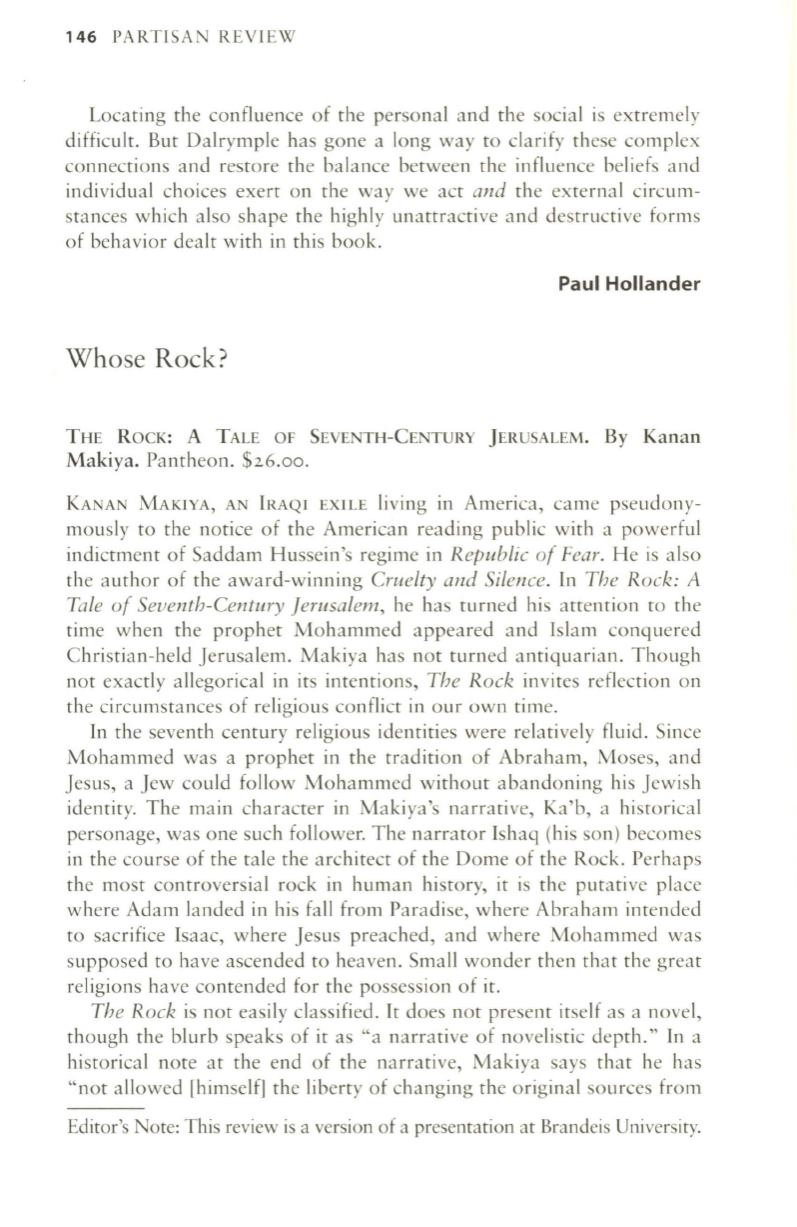
146
PARTI SAN REVI EW
Loca ting th e confluence o f the persona l and th e socia l is extremely
diffi cult. But Dalrympl e has gone a long way to cl a rify th ese complex
conn ecti ons and restore th e balance between th e influence beli efs and
indi vidual choices exe rt on the way we act
and
the extern al circum–
stances whi ch a lso shape th e hi ghl y unattracti ve and destructi ve fo rms
o f behavi or dea lt with in thi s book.
Paul Hollander
Whose Rock?
THE ROCK: A TALE OF SEVENTH-CENTURY JERUSALEM. By Kanan
Makiya. Pantheon.
$ 26 .00 .
KANAN MAKIYA, AN IRAQI EX ILE li ving in Ameri ca , came pse ud ony–
mously to th e notice o f th e American reading public with a powe rful
indictment of Saddam Husse in 's regime in
Republic of Fear.
He is also
the auth or of th e awa rd -winning
Cruelty and Silence .
In
The Rock : A
Ta le of Seventh-Cen tury Jerusalem,
he has turned hi s attenti on to the
time when the prophet Mohammed appea red and Islam conquered
Chri sti an-held j erusa lem. Maki ya has not turned antiqua ri an. Though
not exactl y all egorical in its intenti ons,
The Rock
in vites refl ecti on on
th e circumstances of reli gious confli ct in our own time.
In th e seventh century reli gious identities were rela ti ve ly fluid. Since
Mohammed was a prophet in the traditi on of Abraham, Moses, and
j esus, a j ew could foll ow Mohammed without abandoning hi s j ewi sh
identity. The main cha racter in Maki ya's na rra ti ve, Ka' b, a hi sto ri ca l
personage, was one such foll ower. Th e na rrato r [shaq (hi s son) becomes
in the co urse o f the tale the a rchitect of the Dome o f th e Rock. Perh aps
the mos t controversia l rock in human hi story, it is the putati ve pl ace
wh ere Adam landed in hi s fall from Pa radi se, where Abrah am intended
to sac rifi ce Isaac, wh ere j es us preach ed, and wh ere Mohammed was
supposed to have ascended to heaven. Small wonder then th at the grea t
reli gions have contended for th e possession of it.
The Rock
is not eas il y class ified. It does not present itself as a nove l,
th ough th e blurb spea ks of it as "a na rrati ve o f nove li sti c depth. " [n a
hi sto ri ca l note at th e end o f the na rra ti ve, Maki ya says th at he has
" not all owed Ihimse lf] the liberty of changing th e o ri gin al sources from
Editor's Note: This rev iew is a ve rsion of a presentation at Brandeis Uni ve rsity.


